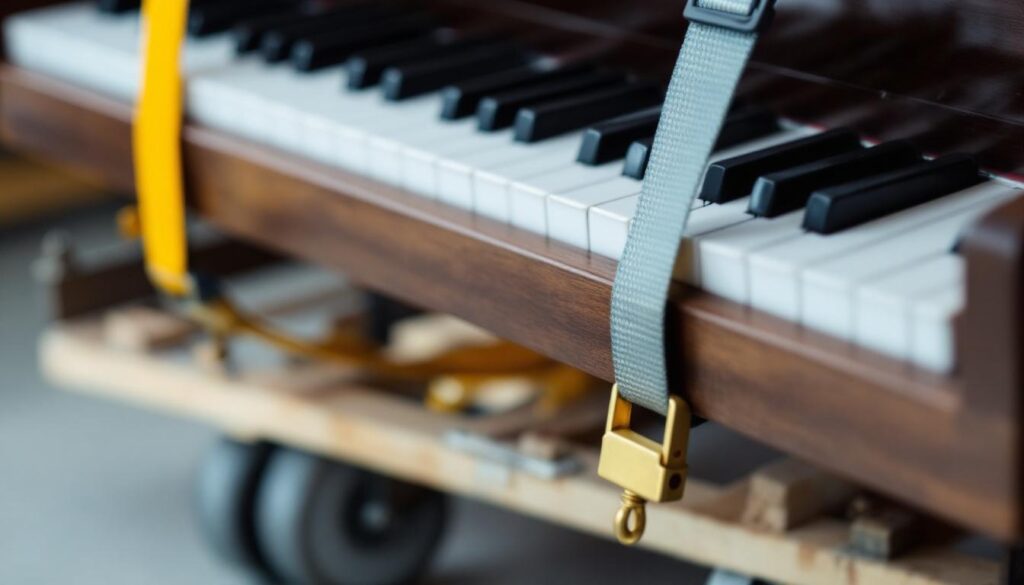Moving a piano is a complex task that requires careful planning and execution. At Southbay Moving Systems, we understand the challenges involved in transporting these delicate instruments.
Our guide on how to transport a piano safely will provide you with essential tips and techniques to protect your valuable instrument during the move. From preparation to proper equipment and transit considerations, we’ll cover all the crucial aspects of piano relocation.
How to Prepare Your Piano for Moving Day
Preparing a piano for transport requires meticulous attention to detail. At Southbay Moving Systems, we’ve refined our piano preparation process over three decades of experience. Here’s how to get your piano ready for its journey:
Secure the Lid and Keys
The first step involves securing the piano’s lid and keys. For upright pianos, close and lock the lid over the keys. If your piano lacks a lock, pad the lid with a moving blanket or thick towel, then secure it with packing tape. (Avoid applying tape directly to the piano’s finish.)
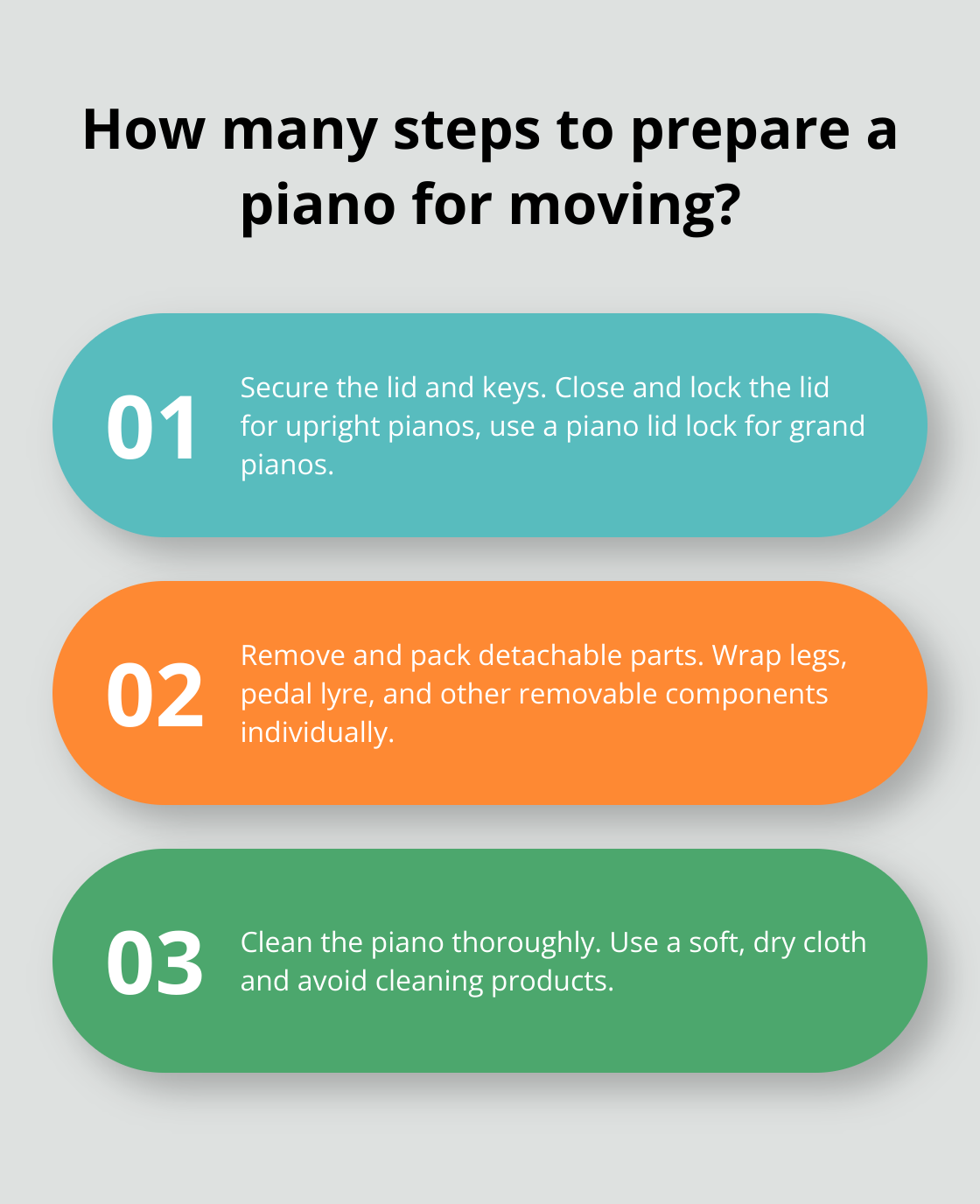
For grand pianos, lower the lid and secure it with a piano lid lock. These new improved devices prevent the lid from opening during transit and avoid marring the wall when leaning the piano lid against it. Without a lid lock, pad the lid with moving blankets and secure them with piano-specific straps.
Remove and Pack Detachable Parts
Next, focus on the detachable parts. For grand pianos, this typically includes the legs and pedal lyre. Use a wrench to remove these parts carefully, then wrap each one individually in bubble wrap or moving blankets. Store small hardware in labeled plastic bags to prevent loss.
Upright pianos may have removable music stands, trays, front panels, or bottom boards. Consult your piano’s manual or a professional technician if you’re unsure which parts you can safely remove.
Clean and Cover the Piano
Before covering, clean your piano thoroughly. Use a soft, dry cloth to remove dust from all surfaces. For stubborn dirt, slightly dampen the cloth with water. (Avoid using cleaning products as they may damage the finish.)
Once clean, cover the entire piano with moving blankets. Start at the top and work your way down, ensuring protection for every surface. Secure the blankets with piano straps or high-quality packing tape, taking care not to apply tape directly to the piano’s finish.
Assess the Moving Path
Before the actual move, assess the moving path your piano will take from its current location to the moving truck. Map out the route in both the existing location and the new one. Measure your piano as well as the door frames, staircases, and hallways to ensure adequate clearance. Remove any obstacles that might impede the move, such as furniture or decor items.
While these steps help protect your piano, moving such a valuable and delicate instrument often requires professional expertise. The next section will discuss the proper equipment and techniques for safely transporting your piano.
Essential Equipment and Techniques for Piano Moving
Specialized Tools for Piano Relocation
Piano moving requires specific equipment to ensure safety and efficiency. Piano dollies stand out as indispensable tools. These aren’t standard furniture dollies; they’re engineered for pianos, featuring a wider base and higher weight capacity. The J-4010 Jansen heavy duty upright piano dollies are designed to easily move heavy studio and upright pianos, equipped with 5″ ball bearing casters.
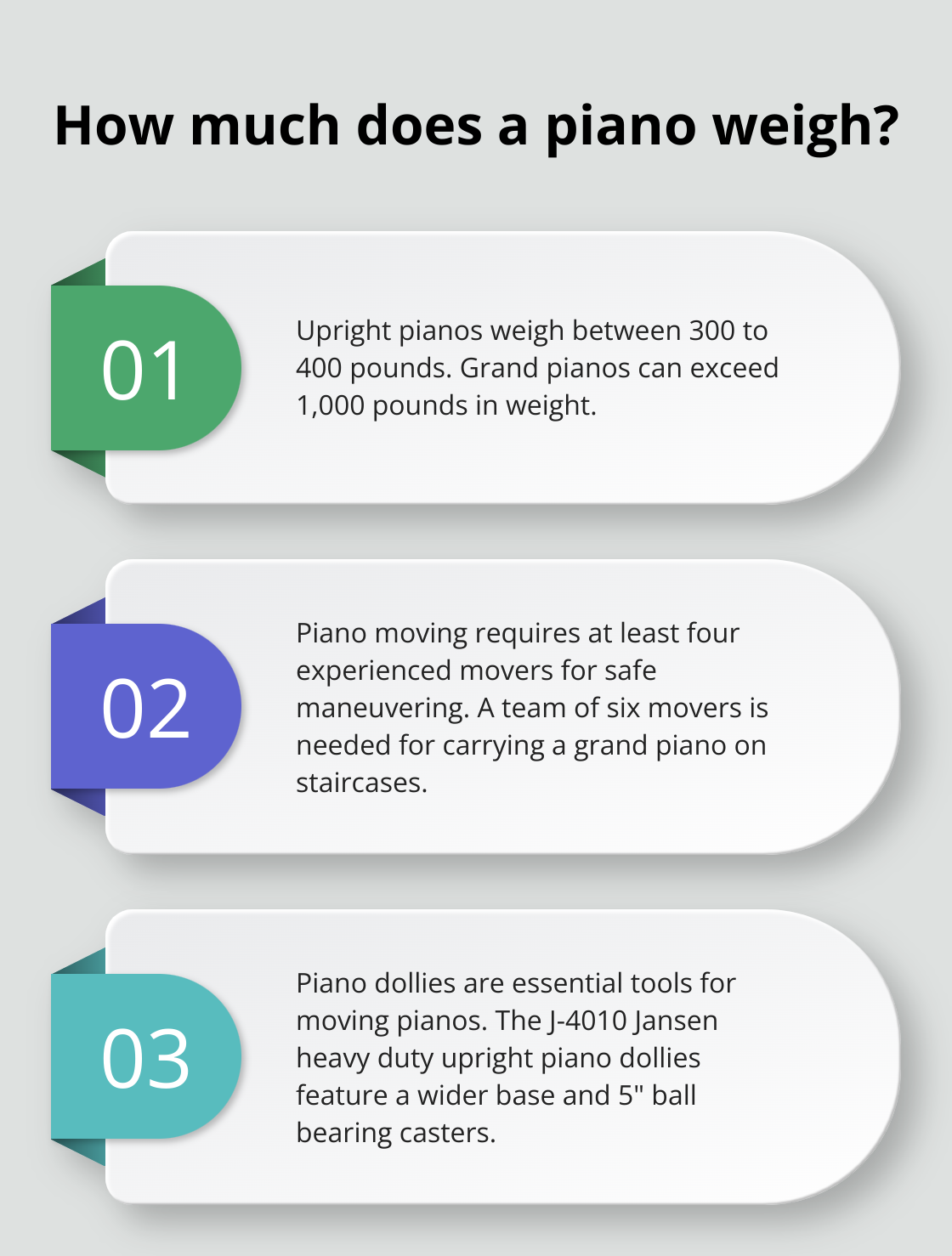
Piano straps play an equally vital role. These heavy-duty straps secure the piano to the dolly and provide crucial support during transport. Professionals use at least four straps for an upright piano and six for a grand piano to maximize stability.
The Importance of a Skilled Team
Piano moving demands a coordinated team effort. Even a small upright piano weighs between 300 to 400 pounds, while a grand piano can exceed 1,000 pounds. A team of at least four experienced movers ensures safe maneuvering of these instruments.
Each team member must understand their role and the moving plan. Clear, concise commands and signals facilitate coordination, especially when navigating tight spaces or stairs.
Proper Lifting and Moving Techniques
Correct lifting technique prevents injury and protects the piano. Movers lift with their legs, maintain straight backs, and keep the piano close to their bodies. For upright pianos, the instrument tilts back onto the dolly, never resting on its legs during transport.
Grand piano moving involves a different approach. Movers first remove the legs and pedal lyre. The piano then rests on its side on a specially designed board. This method, known as “splitting the grand,” allows easier maneuvering through doorways and halls.
Navigating Stairs and Challenging Spaces
Stairs present unique obstacles in piano moving. A specialized stair-climbing dolly allows for controlled movement of upright pianos up or down stairs. Grand pianos require a piano board and a team of at least six movers to carefully carry the instrument on staircases.
These techniques require practice and experience to execute safely. Many people opt to hire professional piano movers who possess the expertise to handle even the most challenging relocations. The next section will explore how to protect your piano during transit, ensuring it arrives at its destination in perfect condition.
How to Safeguard Your Piano in Transit
Comprehensive Padding and Protection
The first line of defense against transit damage is thorough padding. Piano blankets offer superior protection compared to standard moving blankets. These blankets are thicker and conform to the piano’s shape, providing a snug fit that prevents shifting during transport.
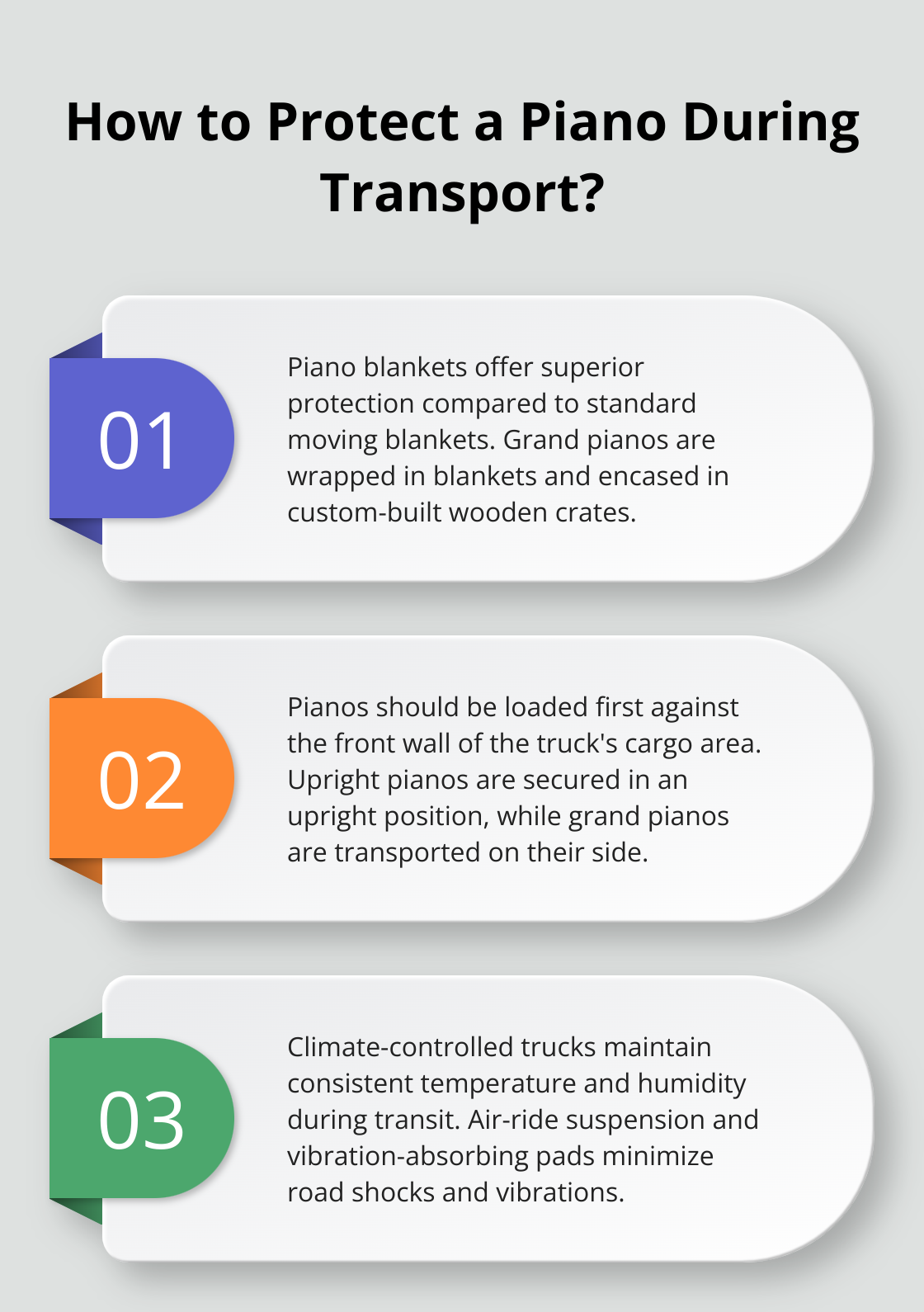
For grand pianos, we use a technique called “nesting.” This involves wrapping the piano’s body in blankets, then encasing it in a custom-built wooden crate. This method offers unparalleled protection for these valuable instruments.
Strategic Placement in the Moving Truck
Proper positioning within the moving truck is essential for piano safety. Load the piano first, placing it against the front wall of the truck’s cargo area. This location minimizes movement and vibration during transit.
Secure upright pianos in an upright position, never on their side. Transport grand pianos on their side to distribute weight evenly and reduce stress on the instrument’s frame.
Once in place, use a system of straps and braces to immobilize the piano completely. This prevents any shifting or tipping that could occur during sudden stops or turns.
Climate Control and Vibration Management
Pianos are sensitive to temperature and humidity fluctuations. Climate-controlled trucks maintain a consistent environment throughout the journey, preventing cumulative, potentially irreparable damage during your piano’s journey.
To minimize vibration, use air-ride suspension in moving trucks. This system absorbs road shocks, providing a smoother ride for your piano. Additionally, place vibration-absorbing pads under the piano’s base for an extra layer of protection.
Monitor the cargo area’s climate throughout the entire move, adjusting as necessary to maintain optimal conditions.
Professional Expertise
While these methods help protect your piano, professional movers (like those at Southbay Moving Systems) possess the expertise to handle even the most challenging relocations. They understand that your piano is more than just an instrument – it’s an investment and often a cherished family heirloom.
A comprehensive approach to piano transport ensures that your valuable piano arrives at its new home in the same condition it left, ready to fill your space with beautiful music once again.
Final Thoughts
Transporting a piano safely requires careful planning, specialized equipment, and expert handling. We at Southbay Moving Systems understand the intricacies involved in piano relocation. Our team has refined the skills necessary to transport pianos safely and efficiently over our 30 years of experience in the moving industry.
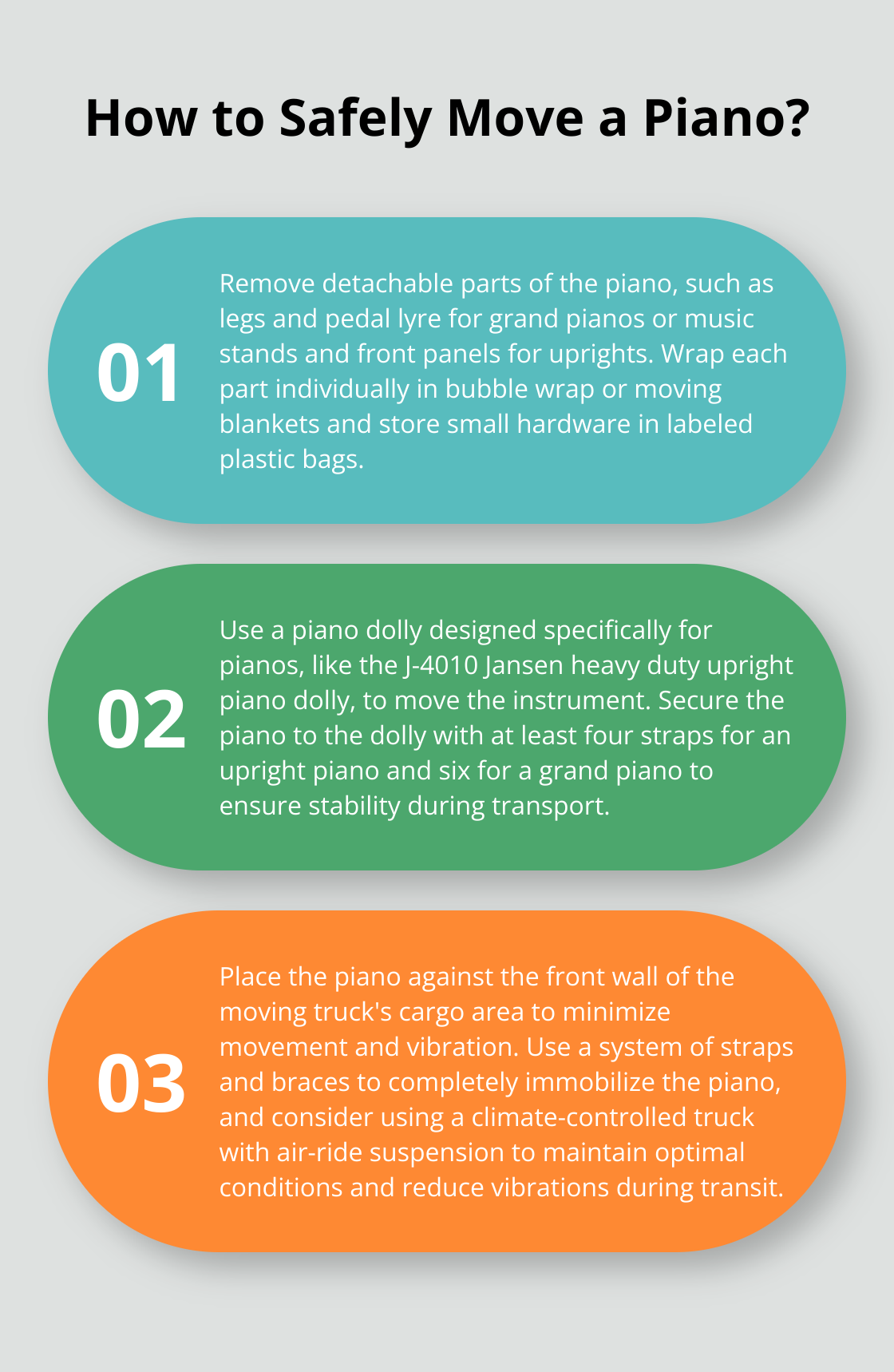
Our expertise extends beyond piano moving to a comprehensive range of relocation services for residential and commercial clients. We approach every job with meticulous attention to detail, ensuring your piano (and all your belongings) arrive at their destination in perfect condition. Our fully licensed and insured services, coupled with our partnership with National Van Lines, provide peace of mind throughout the entire moving process.
If you want to know how to transport a piano safely, trust the experts. Contact Southbay Moving Systems today to ensure your piano receives the care and attention it deserves during your next move. With our expertise, you can rest assured that your piano will be in good hands from start to finish.

